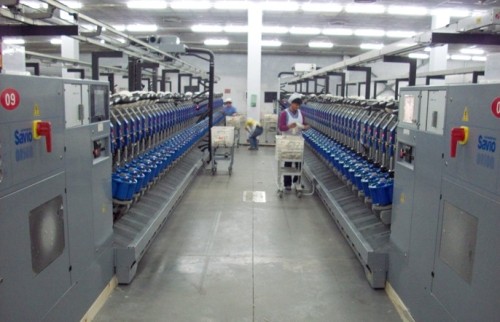High-end textile machinery opportunities
 The impact of the European sovereign debt crisis is still spreading, and the follow-up impact of the international financial crisis continues to show. The international market continues to be sluggish and the outlook is uncertain. In the United States, the global import of textiles and apparel in 2011 increased by 8.6% from the previous year, and it only increased by 3.4% in January-April this year. The EU’s demand dropped significantly. From January to May, China’s exports to the EU dropped by 11.2%. The domestic market was subject to price Due to factors such as high levels, lack of market confidence, and so on, it also showed a trend of slower growth.
The impact of the European sovereign debt crisis is still spreading, and the follow-up impact of the international financial crisis continues to show. The international market continues to be sluggish and the outlook is uncertain. In the United States, the global import of textiles and apparel in 2011 increased by 8.6% from the previous year, and it only increased by 3.4% in January-April this year. The EU’s demand dropped significantly. From January to May, China’s exports to the EU dropped by 11.2%. The domestic market was subject to price Due to factors such as high levels, lack of market confidence, and so on, it also showed a trend of slower growth. It is at this low tide that China's textile industry and even the downstream listed companies in the apparel industry are losing money. For losses, related companies stated that the primary reason is that the domestic and international market prices of cotton have been seriously inverted. International cotton prices have been significantly lower than domestic cotton prices, which has resulted in high production costs and seriously affected the efficiency of enterprises and market sales. The cost of various types of labor costs continued to rise, especially the increase in labor wage costs. At the same time, the shortage of labor resources also restricted the fullness of production capacity. Because it is located in the economically developed eastern region, the shortage of labor force has become the bottleneck of the company's full-time production. The reduction in the production rate of enterprises has affected the development of production capacity.
These companies are not optimistic about the industry trend in the second half of the year. The company stated that as a textile industry company, there are more factors restricting steady growth. The price of textile raw materials such as cotton has been significantly reduced to reduce the profitability of enterprises; the current cost of textiles has been under pressure; the prices of textile raw materials such as cotton have not yet returned reasonably; domestic and international cotton prices are difficult to converge; labor, energy and other prices will not fall, and credit policies will not Will be relaxed, the product terminal price conduction is relatively lagging and sluggish. In light of the above, the growth rate of the industry will continue to decline over the first half of the year.
At the same time, in response to the downturn in the textile industry, the Consumer Products Industry Division also predicts that textile companies will remain in a more difficult position in the second half of the year, textile and apparel exports will continue to grow at a low level, and the overall growth rate of the industry will decline sharply from the previous year. The losses of loss-making enterprises will all expand, and more medium, small and micro enterprises will face the risk of being eliminated.
However, relative to the downturn in the textile industry, potential demand for machinery and equipment still exists, which is mainly reflected in the demand for high-end textile machinery.
According to experts, by 2017, the total global textile machinery market will reach 22.9 billion U.S. dollars. It is expected that Asian textile manufacturers will have the largest proportion of new equipment investment. According to statistics, in May of this year, 90% of the world's new spinning machines, shuttleless looms and flat knitting machines were imported into Asia, especially into China. There is no doubt that Asia is still the world's textile and apparel manufacturing center.
Facing China's big market, world-renowned textile machinery manufacturers have set up factories in China to implement localized production and services.
In recent years, with the acceleration of the pace of upgrading China's textile industry, the product structure of the textile machinery market has undergone tremendous changes, the proportion of traditional textile equipment sales has become less and less, automation, continuous, high-speed, intelligent The sales volume of chemical equipment and large-capacity textile machinery increased significantly. Gao Yong, vice president and secretary-general of the China National Textile and Apparel Council, pointed out that the changes in the demand for these devices reflect the adjustment of product structure and industrial upgrading in the textile industry in China. On the other hand, the textile industry is currently trapped in labor costs and raw material costs. The inevitable choice to rise. The use of high-speed, intelligent, and large-capacity textile machinery equipment by textile companies can reduce labor and improve efficiency. At the same time, in view of the current global shortage of raw materials such as cotton, it is necessary to make full use of good fibers and increase the added value of products. . In the next 5 to 10 years, this demand trend will become more apparent.
1) Acid value can be used as the index of oil deterioration degree, single
(Mg KOH /g);
2) The amount of acid value of oils and fats and the raw materials,
The technology of oil making and processing, and the storage and transportation of oil and grease
Method and storage and transportation conditions.
For example: ripe oil
Seed less mature or germinating moldy seeds
The acid value of grease is lower;
Free Fatty Acids Test Strips,New Acids Test Strips,Accurate Fry Oil Test Kit,Cooking Oil Test Strips
Jilin Test Bio-Electron Co., Ltd , https://www.tst-check.com